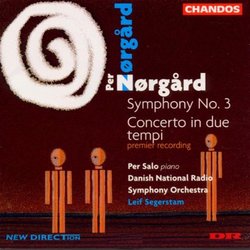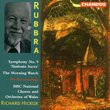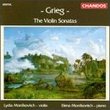| All Artists: Per Norgard Title: Per Nørgård: Symphony No. 3; Concerto in due tempi Members Wishing: 0 Total Copies: 0 Label: Chandos Release Date: 1/21/1997 Genre: Classical Styles: Forms & Genres, Concertos, Instruments, Keyboard, Symphonies Number of Discs: 1 SwapaCD Credits: 1 UPC: 095115949122 |
Search - Per Norgard :: Per Nørgård: Symphony No. 3; Concerto in due tempi
 | Per Norgard Per Nørgård: Symphony No. 3; Concerto in due tempi Genre: Classical
|
Larger Image |
CD DetailsSimilar CDs |
CD ReviewsA symphony of indescribable beauty and complexity, along wit Christopher Culver | 05/28/2006 (5 out of 5 stars) "This Chandos disc, another in the line of Per Norgard's symphonies, contains his great third symphony, often regarded as his masterpiece, and is filled out with his "Concerto in due tempi". The Danish National Radio Symphony performs, conducted by Leif Segerstam, with the Danish National Radio Choir on the symphony and pianist Per Salo as soloist on the concerto. Per Norgard's first great invention of musical structure was the "infinity series", a striking method of serializing melody that creates self-similarity among orchestral parts, an unsuspecting application of fractal mathematics to music. This principle was first overtly displayed in the second movement of "Voyage into the Golden Screen" (1968), available on a fine Da Capo disc, and listening to this is the best way to grasping the concept at its simplest. A given melody is played by the flutes in what can be called "normal time", while the oboes play every fourth note, the trumpets every 64th note, and tubular bells, trombones, and piano every 256th note, and so on for 1024 notes. Norgard's second symphony, written in 1970, was simply a application of this same technique with a longer running time and expanded instrumentation. In the years immediately following, Norgard began developing harmonic and rhythmic techniques that would augment his melodic serialisation. For harmony, he chose to use the natural overtone series, since this is itself infinite: any harmonic series also has a new harmonic series on each of its partials. For rhythm he chose to use the golden section, the ratio that the Fibonacci sequence approaches, praised since ancient times as the "divine proportion" and also used widely by Sofia Gubaidulina. Sounds organized in such a fashion are pretty much guaranteed to be aesthetically pleasing, and that's why "Symphony No. 3" (1972-1975) is a veritable triumph. Since the entire work is ingenious sculpted out of these perfect shapes, then I would even dare to say that if someone doesn't enjoy this, they lack a certain humanity. The first movement is powerful but somewhat restrained, and consists of an introduction in two parts followed by two main sections. After an introduction of simple harmonic and melodic material over regular rhythms, the three infinity series are revealed in what is surely one of the most awesome moments in musical history. All things here are so audibly united, and one can even say that this music, with its natural inspirations (for overtones and the Fibonacci sequence were discovered, not invented) represents the glory of creation. It is in this spiritual ecstasy that we enter the second movement, where Norgard has the chorus sing "Alleluia" in ecstasy and then sets three Marian hymns and a Rilke poem. The composer had already set Rilke's "Singe die Gaerten, mein Hertz, die du nicht kennst" for chamber choir and eight instrumentalists earlier in 1975, but decided that it would make a perfect end for the symphony. And so, personal experience is united with the grandure of the universe in this amazing, epic piece. Segerstam ensures a perfectly elegant pacing and feel here, and I think the performance could be seen as definitive. There's an earlier performance out there on Marco Polo with Herbert Blomstedt conducting the same ensembles, but it seems rather idiosyncratic and jerky in comparison and the recording quality is nowhere near as good. Norgard's piano concerto "Concerto in due tempi" (1994/95) came after two decades of further experimentation where the infinity series was still an inspiration but other aspects had come to interest the composer. In this piece, Norgard sets out two musical lines that coexist alongside one another, but which move at different speeds, never meeting but sometimes "merging". Sometimes the slow line is foremost, while at other times the faster line is dominant. Per Salo races flawlessly through some tricky music, including a fiendishly complex solo in the middle, and this stands out as one of the finest piano performances I've ever heard--the piano is also recorded quite well. The concerto is indeed entertaining listening, and like the symphony does not alienate the listener in spite of its formidable theoretical basis (it's certainly not "modern" sounding like, say, Elliott Carter). I haven't become entirely comfortable with it yet since I don't grok its structural underpinnings, but I can say it sounds good. Per Norgard has, I daresay, contributed to the technique of music in our time more than any other single composer, and this disc is a great opportunity to hear some emotionally moving and intellectually provocative concepts. Highly recommend." Marvellous Musical Monolith Christopher Culver | 08/01/2000 (5 out of 5 stars) "In Per Norgard's 3rd Symphony, one seems to be hearing some extraordinary natural process at work - as if a mountain were growing from a few initial tendrils of delicate sound. For all of the monumentality of the work's structure, the sound itself is often remarkably subtle and elusive - some of the piece's most striking auditory effects are at the very edge of audibility. At times it sounds as if one is hearing a gigantic aeolian harp, not an orchestra at all. All of this accords beautifully with the Rilke text set for chorus in the second movement, which muses on the delicate web of filaments that binds all creation together. Marvellous stuff, excellently played." Norgard's Masterpiece Christopher Forbes | Brooklyn,, NY | 03/03/2003 (5 out of 5 stars) "The Symphony No. 3 is probably Danish composer, Per Norgard's most popular work, and justly so. This work is the crowning achievement in his third musical phase and the most brilliant work he wrote based on pure infinity series processes. Paired with the Concerto in Dui Tempi, an intriguing and witty work from the 90s and you have a wonderful portrait of this special Nordic composer. The Symphony No 3 of Norgard's is a monumental work. In it, the composer makes the greatest exploration of the unity behind all things that he percieved in nature and wished to express in music. Norgard made us of many of the formal structures from his Second Symphony and his opera Gilgamesh, most particularly the infinity series, a melodic construction based on "projection of intervals" a process resembling the self similar results of fractal algorhithms. In this work, Norgard experiments more freely with his melodic process, letting the infinity series recede into the background while other melodies based on various manipulations of the series and on his own intuition come to the fore. In addition, Norgard adds a beautiful harmonic element based on the acoustic scale and a new sense of rhythm derived from the Golden Section ratio. All of this sounds dry, but the result is anything but. The first movement of the symphony starts with descending scales based on the harmonic series which coelesce into lovely harmonies. The work then moves through a bewildering variety of textures and moods. Unlike his two previous orchestral works, there is no unbroken undulating statements of the infinity series. Rather the device crops up and disappears but is always present somewhere underneath the structure giving the entire work shape and direction. The second movement is even more stunning than the first. It begins with a long orchestral introduction, brimming with lyrical ecstasy. There are echos of Sibelius and Nielsen throughout the movement. Half way through the chorus enters, first wordlessly, but then to the text of the Ave Maria Stellis. Finally, the entire ensemble breaks forth into a complete setting of one of Rilke's Sonnets to Orpheus, Singt die Garten meine Herz. This is an expansion of one of Norgard's most successful choral works (the original can be heard on the Chandos disc, Frostpsalm) and has all the power of the Mahler 8th or, dare I say it, the Beethoven 9th. As a final gesture, Norgard even quotes briefly from Schubert's Du Bist die Eine Ruhe...given a new and more sacred meaning in the context. It is a glorious and overwhelmingly positive faith statement. In fact, the score itself is dedicated to the glory of God. The Concerto is a wholy different affair. Written in the early 90s, it is more dissonant in style than Norgard's earlier work. In the intervening years, the composer had become fascinated by the work of schizophrenic artist, poet and composer, Adolf Wolfli and his music had taken on a much darker quality...more avant-garde and less tonal, though by no means serial. The Concerto partakes of this darker language, but is at heart a more bouyant work. The two tempi of the title represent the work's basic formal procedure. Norgard wished to experiments with the cumulative effect of music in two tempi based on non-rational numbers. All rhythmic and tempo relationships in the work are based on the square root of 2. Both tempi in each relationship are always present, though sometimes one predominates and the other fades into the background. The writing for the piano soloist is highly vituoso, with a slightly jazzy sound, unusual for Norgard. The resulting work is full of high spirits even in it's darkest parts. This is a wonderful continuation of the Norgard series on Chandos. Orchestra, soloists and conductor are all in top form. Even if you are not a fan of modern music, I can't imagine that the Symphony won't win you over. It is lush and almost romantic. Highly recommended CD!"
|

 Track Listings (3) - Disc #1
Track Listings (3) - Disc #1


